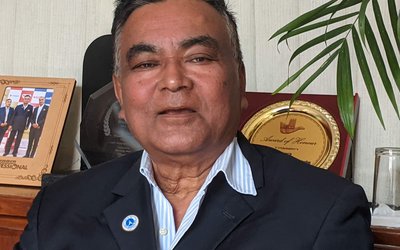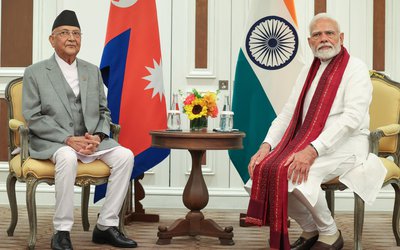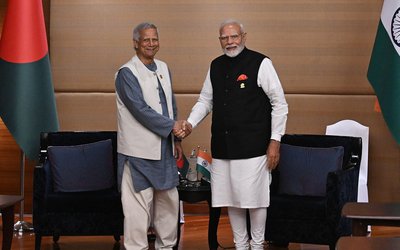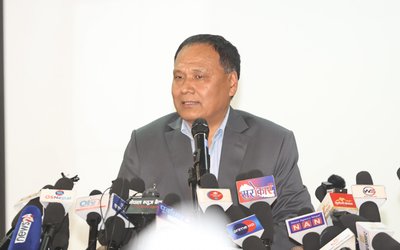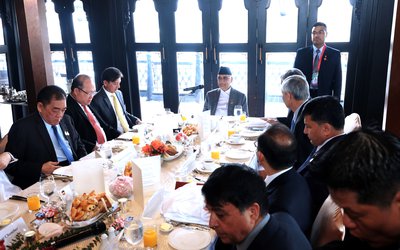
Having served in key positions in climate change and disaster related works, including in NAPA and PDNA, at the top level, Purushotam Ghimire, who is now the focal point of the disaster division of National Planning Commission, is retiring next week. Fifty-eight-year old Ghimire spoke to NEW SPOTLIGHGT on various issues. Excerpts:
How do you like to look at Nepal now?
Nepal is one of the countries at a high risk of disaster. In terms of climate change vulnerability, Nepal stands in the fourth position, in terms of earthquake at 11th and in water induced disasters at 20th. Although Nepal is very vulnerable to disasters, we paid hardly any attention to disasters at the national level earlier. However, Nepal started to pay a holistic attention on disaster only after 2007 when Nepal was asked to prepare National Adaptation Program of Action (NAPA) as obligatory of Least Developed Countries to acquire international funding to deal with the impact of climate change. However, Nepal started NAPA process only in 2008 and I was the National Project Director. We prepared the NAPA document very early. After the document, we also prepared a document for adoption with urgent and emergency needs.
How do you show linkages between NAPA and disasters?
We have made every effort to link NAPA with disasters. We know that natural disaster is a national issue and climate change is international. We argued that disaster related problems need to be addressed through national programs. After making studies, we came to realize the impacts of climate change that made Nepal more vulnerable to disasters. We made every effort to coordinate between them. However, all our efforts went in vain.
Is disaster only the Home Ministry’s concern?
One must understand that disaster is not a property of Ministry of Home Affairs. This is a cross-cutting issue and all line ministries, communities, civil society organizations and local bodies need to come together on it. If we look at the cycle of disaster, it will have preparedness, rescue, relief, recovery and rehabilitation. Every institution needs to make preparedness, relief, recovery; reconstruction and rehabilitation are cross cutting issues. However, rescue is the only issue related to Ministry of Home Affairs. So far as reconstruction and rehabilitation are concerned, these are yet to take place. Nepal government is yet to make a coordinated approach to deal with disasters. Despite the fact that disasters involve so many things, they have remained under the periphery of Ministry of Home Affairs.
What are the weaknesses in disaster handling?
One of our weaknesses is that the disaster is still governed by Natural Disaster Relief Act 1981, which is incomplete as well as insufficient to deal with the broader issues of natural disaster. For the first time, an effort had been made to amend the act bringing the new concept of formation of Natural Disaster Authority. However, the old bill collapsed following the dissolution of CA I. The recently tabled bill has once again removed all the good concepts introduced in the last bill making natural disasters a part of Ministry of Home Affairs.
How do you look at the recently tabled Disaster bill?
The recently tabled bill has many flaws and it is a continuation of the old act. One of the major weaknesses of the bill is that it does not recognize the role of civil society organizations, community, private sectors and other government line agencies. The bill simply strengthens the authority of Ministry of Home Affairs. Despite the opposition from various other ministries, the cabinet committee has cleared the bill with high-handedness of deputy prime minister and Home Minister Bam Dev Gautam.
Do you think Ministry of Home Affairs alone deals with the disaster?
As natural disaster involves so many complexities, the home ministry alone cannot do anything. There is the need to have the involvement of all different agencies and line ministries. During the course of discussions in the parliament, the bill is likely to be amended, making it effective. If the bill is passed as it was tabled, it will be another disaster.
Why does the bill need amendment?
The bill needs to address the issues related to climate change, sustainable development and green growth. When the bill was in debate at the cabinet committee, I objected to the provisions of the bill. We need to continue to oppose the provisions of the bill that make disaster as the core issue of Ministry of Home Affairs.
What has Nepal learnt from the recent disaster?
Despite some lapses, Nepal Army, Police, government offices, local bodies and civil society organizations had done a great job in search, rescue and rehabilitation.
How do you look at the recent National Reconstruction Authority ordinance?
The recent National Reconstruction Authority ordinance has focused on reconstruction for five years. It is unfortunate that the government is yet to nominate its CEO. The time is running out. The present budget even said that the line ministries will be responsible to carry out the reconstruction work till the formation of authority. If the situation goes like this, it will be impossible for the authorities to function properly. The authorities need rules and regulations as well as administrative set up to work in 14 earthquake devastated districts and 31 less affected ones.
How do you view the achievements of the last three months?
We developed PDNA which identified 23 sectors including 17 major sectors and 6 cross cutting sectors. We prepared PDNA, held international conference and donors expressed their commitment of the needed billions of dollars. We don’t have any problem of money now. Even the government has surplus money. Our development expenditure is rarely spent fully, often only 80 percent.
What will be its implications?
If we don’t appoint the CEO in time, donors may not wait for us for a long period of time. We had bitter experiences of failing to utilize the money committed by Nepal’s development partners in climate change. In some cases, the money allocated to Nepal has even been diverted to other countries. If we are unable to work properly, one cannot rule out the possibility of money being diverted other parts of the world.
There is a lack of coordination among the government agencies in disaster management. That institution which holds DRR, it does not want to see other agencies to take work. We had seen how uncoordinated our efforts were during the earthquake. We don’t have an established mechanism. We need to empower communities to effectively deal with disasters. Identifying the risk and vulnerability areas, we need to empower communities to address the disasters. We need to provide equipment and volunteers. Centers, regions and districts need to play coordinating roles, what is needed is to increase the level of awareness among the community.
What needs are there then?
One of the problems is that there is no connection between the Disaster Bill and National Reconstruction Authority Bill. There is no link with National Planning Commission up to the village level. There is still much confusion about who should do what. The frustration is growing and people have started to build their own homes. People are so much frustrated.
- IME GROUP: Expands Into Paper Industry
- Mar 24, 2025
- CPN UML: Instigated By India
- Mar 23, 2025
- ADB’S CHIEF ECONOMIST: Nepal Reduces Poverty
- Mar 11, 2025
- FM DR. DEUBA: A Successful Visit
- Mar 11, 2025
- MD GHISING: Target Of Personal Grudge
- Mar 09, 2025





